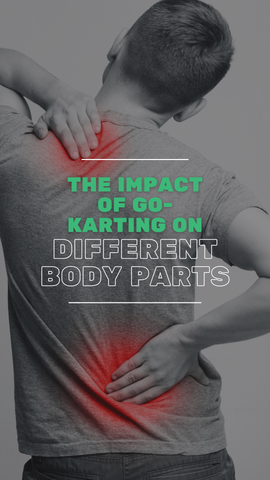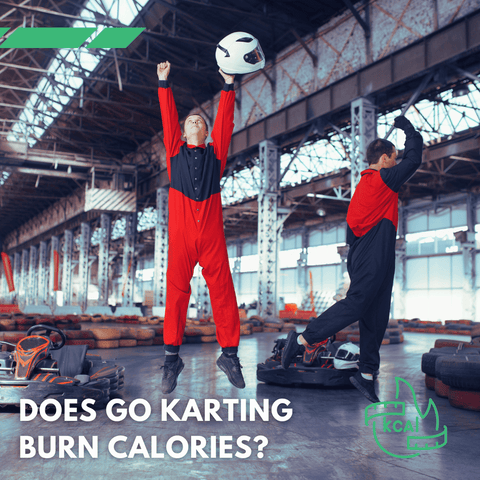
Why Is Go Karting So Tiring?
Go-karting, also known as karting, is a form of motorsport that involves driving small, four-wheeled vehicles called go-karts or racing karts.
If you're interested in this sport, RiiRoo has a wide variety of options to choose from. 
It originated in the United States in the 1950s and has since become a popular recreational activity and a stepping stone for aspiring race car drivers.
Learn more about the history of go-karts and how they became a favourite activity for kids.
Go-karts are designed for high-performance racing, offering speed, agility, and maneuverability on various tracks.
If you're curious about high-performance karts, here's a guide that could help.
Explanation of Why Go-Karting Can Be Tiring
Go karting is physically demanding due to several factors. Firstly, the constant steering and maneuvering require significant upper body strength.
Secondly, the high speeds and G-forces experienced during racing can strain the muscles and increase fatigue.
Additionally, the adrenaline rush and intense concentration needed contribute to mental exhaustion.
Overall, the combination of physical exertion and mental focus makes go karting a tiring activity.
Related: Does Go Karting Burn Calories?
Physical Exertion and Cramped Seating Position
One of the primary reasons why go-karting can be tiring is the physical exertion required to operate the vehicle.
Go-karts are typically low to the ground and require the driver to sit in a cramped position.
The constant bending of the knees and the pressure exerted on the body while navigating tight corners can quickly lead to discomfort and fatigue.
High Speeds, Quick Reflexes, and Constant Steering
Go-karts are capable of reaching high speeds, and the need for quick reflexes and constant steering adds to the physical demands of the sport.
The driver must maintain focus and react swiftly to changing track conditions and competitors' movements.
The combination of speed and agility places a significant physical burden on the body, especially the upper extremities.
| Common Body Parts Affected by Go-Karting | Related Symptoms |
|---|---|
| Arms and Grip Strength | Soreness, muscle fatigue |
| Shoulders and Upper Back | Muscle soreness, tension |
| Ribs and Midsection | Soreness, discomfort |
This table provides information on common body parts that can be affected by go-karting and the related symptoms that drivers may experience.
Duration of the Activity and Track Intensity
The duration of go-karting sessions can vary, with some enthusiasts spending hours on end behind the wheel.
The longer the activity, the more fatigued the driver can become. Additionally, the intensity of the track plays a role in determining the level of exhaustion experienced.
Challenging tracks with tight corners and fast straights demand a higher level of physical exertion, leading to increased tiredness.
Lack of Power Steering
Unlike regular cars, go-karts do not have power steering, which assists in turning the wheels with minimal effort.
The absence of power steering means that the driver must rely solely on their strength to maneuver the go-kart, especially during tight turns and hairpin bends.
This additional physical effort can contribute to fatigue, particularly in longer races or extended practice sessions.
The Impact of Go-Karting on Different Body Parts
Arms and Grip Strength
Go-karting puts a significant strain on the arms, particularly the forearms and biceps. 
The constant steering and maintaining a firm grip on the wheel require considerable grip strength and endurance.
Drivers often find their arms fatigued and muscles sore after an intense go-karting session.
The shoulders and upper back also bear the brunt of go-karting physical demands.
The repetitive steering motions, especially during tight corners, engage the muscles in these areas, causing them to work strenuously.
Drivers often describe the sensation of their shoulders and upper back being "on fire" after a challenging go-karting race.
Ribs and Midsection
The midsection, including the abdomen and rib muscles, is subject to substantial forces during go-karting.
The quick acceleration, deceleration, and sharp turns exert G-forces on the body, placing strain on the muscles in the midsection.
As a result, drivers may experience soreness and discomfort in these areas, affecting their overall stamina and endurance.
The Role of G-forces in Go-Karting and its Effect on the Body
G-forces, or gravitational forces, play a significant role in go-karting.
When the go-kart accelerates, turns, or brakes abruptly, the body is subjected to increased G-forces.
Learn more about the science of go-karting and the impact of these forces.
These forces impact the driver, causing strain and exertion on various body parts.
The continuous exposure to G-forces throughout a go-karting session can be physically demanding and contribute to the overall fatigue experienced by drivers.
The Significance of Go-Kart Races and Their Physical Demands
Go-kart races, whether competitive or recreational, demand a high level of physical fitness and endurance from the drivers.
Endurance go-kart races can last for several hours, requiring the drivers to maintain focus, speed, and consistency throughout.
The physical toll of racing in a competitive environment pushes the drivers to their limits, both mentally and physically. Find out more about the financial aspect of go-kart racing.
The Importance of Physical Conditioning and Training for Go-Karting
To cope with the physical demands of go-karting, drivers often engage in physical conditioning and training programs.
Cardiovascular workouts, strength training exercises, and practicing go-karting techniques can improve endurance, muscle strength, and overall fitness.
Proper physical preparation can help drivers reduce fatigue and perform at their best on the track.
Tips to Reduce Tiredness and Physical Strain in Go-Karting
To minimise tiredness and physical strain during go-karting sessions, drivers can consider the following tips:
- Maintain a good posture while driving to minimise discomfort and strain.
- Engage in regular physical conditioning exercises and strength training.
- Take breaks between races or practice sessions to allow the body to rest and recover.
- Stay hydrated and maintain proper nutrition to fuel the body during intense go-karting activities.
- Gradually increase the duration and intensity of go-karting sessions to build endurance over time.
| Useful Tips to Minimise Tiredness in Go-Karting |
|---|
| 1. Maintain a good posture while driving to minimise discomfort and strain. |
| 2. Engage in regular physical conditioning exercises and strength training. |
| 3. Take breaks between races or practice sessions to allow the body to rest and recover. |
| 4. Stay hydrated and maintain proper nutrition to fuel the body during intense go-karting activities. |
| 5. Gradually increase the duration and intensity of go-karting sessions to build endurance over time. |
The Experience of Go-Karting and its Rewards
Despite the physical demands and exhaustion, go-karting offers a thrilling and rewarding experience.
The adrenaline rush, the sense of competition, and the joy of maneuvering a high-performance vehicle make the fatigue worthwhile for many go-kart enthusiasts.
The physical exertion required in go-karting adds to the overall sense of accomplishment and satisfaction when crossing the finish line.
In Summary
Go-karting is undoubtedly a sport that can be physically demanding and tiring.
The combination of physical exertion, high speeds, constant steering, and the duration of the activity can lead to fatigue and exhaustion. However, with proper physical conditioning, training, and adopting strategies to reduce tiredness, go-kart drivers
can enjoy the exhilaration of this sport while minimising the physical strain on their bodies.
FAQs:
Does go-karting require physical fitness?
Yes, go-karting requires a certain level of physical fitness and endurance to cope with the physical demands of the sport. Regular physical conditioning and training can help drivers improve their performance and reduce fatigue.
Can go-karting cause soreness in the body?
Yes, go-karting can cause soreness in various body parts, including the arms, shoulders, and midsection. The physical strain and G-forces experienced during go-karting can lead to muscle soreness and discomfort.
Are there any safety precautions to consider during go-karting?
Yes, safety precautions are essential in go-karting. Drivers should wear proper safety gear, including helmets and protective clothing. It is also crucial to follow track rules and guidelines to ensure a safe and enjoyable go-karting experience.
How can I improve my endurance for go-kart racing?
To improve endurance for go-kart racing, focus on cardiovascular workouts, such as running or cycling. Incorporate strength training exercises that target the arms, shoulders, and core muscles. Consistent practice on the track will also help build endurance over time.
Is go-karting suitable for all age groups?
Go-karting can be enjoyed by people of various age groups. There are go-karts specifically designed for children, and adults can participate in recreational or competitive go-karting events. It is important to check the age and height restrictions at go-karting venues before participating. Learn how to choose the right size pedal go-kart for your child.


